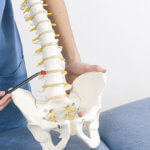Experiencing foot pain? Is it difficult to walk, exercise, or socialize due to this discomfort? It’s really no surprise. Your feet are some of the hardest working parts of your body. Every day, they serve as shock absorbers and buffer up to one million pounds of pressure as you traverse the world. Moreover, they support one and a half times your body weight when you walk, run, or jump.
Approximately 75 percent of Americans will contend with ankle and foot pain at some point in their lives, and if you’re one of them, you know how difficult management can be. Fortunately, you don’t have to be in agony any longer. Physical therapy can help treat the symptoms associated with sprains, strains, and more. Call us today to find out how.
What is Ankle and Foot Pain?
In short, ankle and foot pain refers to discomfort in the web of bones, ligaments, muscles, and tendons that comprise the foot or ankle. It can impact any area between your toes to your Achilles tendon at the back of your heel and can be long-lasting, in short bursts, or sporadic.
If you’re dealing with such pain, any pressure put on the foot can exacerbate the irritation. Running, jumping, walking, or stretching only amplifies the tenderness, which is an overwhelming motivator for people to pursue treatment.
Causes of Foot and Ankle Pain
Home to one-quarter of the bones in the human body, the foot boasts an impressive number of sensitive spots. There are 26 bones, 33 joints, and more than 100 tendons, ligaments, and muscles in your tootsies, making the likelihood of injury tremendous. From footwear to inflammation, and from injuries to certain medical conditions, your feet are susceptible to pain with nearly every decision you make. And where your foot is involved, so too is the ankle. The foot and ankle go, well, hand in hand.
It’s no wonder then that foot injuries are incredibly common. A misstep, a sudden fall, a sharp object underfoot, and you could suddenly be in a lot of pain.
Here is a short list of some of the most common causes of foot pain:
- Tendinitis
- Stress fractures
- Strains
- Sprains
- Septic arthritis
- Rheumatoid arthritis
- Raynaud’s disease
- Peripheral neuropathy
- Osteoarthritis
- High heels and poorly fitted shoes
- Gout
- Diabetic neuropathy
- Bursitis
- Broken bone
- Bone spurs
- Achilles tendon rupture
- Achilles tendinitis
How Physical Therapy Helps Foot and Ankle Pain
Armed with a skilled physical therapist and a willingness on your part to actively participate in treatment, you can experience a significant decrease in foot pain and eliminate the majority of problems that people have with their feet and ankles. While there are a variety of home remedies, chronic or debilitating pain warrants a trip to a specialist.
The first step to take is to visit your primary care specialist to ensure that there is no risk of further injuring yourself and that an untreated condition such as diabetes isn’t the cause. If your health care provider agrees, your next step is a visit to a physical therapist.
In the realm of physical therapy, a person’s walking pattern is a window into their condition. It serves as a means for physical therapists to ascertain your level of functioning and determine if treatment is working. As such, you can expect a quick evaluation of your walk at every appointment. This will help direct the course of diagnosis and treatment.
Along with this essential element of treatment, a physical therapist will use a variety of tools to help alleviate your pain. This may include massage, stretching techniques, manual manipulation, ultrasound, and different exercises to help build strength and restore mobility while reducing pain.
In addition to the above techniques, your physical therapist may also recommend specialized footwear. Though many of us seek out soft shoes, this tendency plays a huge role in our discomfort. Well-developed orthotics can make a significant difference in your level of foot and ankle pain, and your physical therapist can recommend the most suitable option for you.
If you’re ready to forgo pain and want a long-lasting remedy, contact us to schedule an appointment and visit at Prospect Park & Secaucus, NJ centers.






